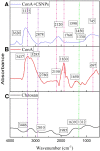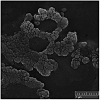Targeted delivery of a short antimicrobial peptide (CM11) against Helicobacter pylori gastric infection using concanavalin A-coated chitosan nanoparticles
- PMID: 37650975
- PMCID: PMC10471652
- DOI: 10.1007/s10856-023-06748-w
Targeted delivery of a short antimicrobial peptide (CM11) against Helicobacter pylori gastric infection using concanavalin A-coated chitosan nanoparticles
Abstract
Helicobacter pylori is the cause of most cases of stomach ulcers and also causes some digestive cancers. The emergence and spread of antibiotic-resistant strains of H. pylori is one of the most important challenges in the treatment of its infections. The present study aims to develop a concanavalin A (ConA) coated chitosan (CS) nanocarrier-based drug delivery for the targeted release of peptides to the site of H. pylori infection. Accordingly, chitosan was used as an encapsulating agent for CM11 peptide delivery by applying ionotropic gelation method. Con-A was used for coating CS nanoparticles to target H. pylori. The CS NPs and ConA-CS NPs were characterized by FTIR, dynamic light scattering (DLS), and scanning electron microscopy (SEM). The MIC of CM11-loaded ConA-CS NPs against H. pylori SS1 strain was analyzed in vitro. In order to evaluate the treatment efficiency in vivo, a gastric infection model of H. pylori SS1 strain was established in mice and histopathological studies and IL-1β cytokine assay were performed. Based on the results, the size frequency for CS NPs and ConA-CS NPs was about 200 and 350 nm, respectively. The prepared CM11-loaded ConA-CS NPs exhibited antibacterial activity against H. pylori SS1 strain with a concentration of 32 µg/ml. The highest healing process was observed in synthesized CM11-loaded ConA-CS NPs treatments and a significant decrease in IL-1β was observed. Our findings highlight the potential of chitosan nanoparticles as a drug delivery vehicle in the treatment of gastric infection model of H. pylori SS1 strain.
© 2023. The Author(s).
Conflict of interest statement
The authors declare no competing interests.
Figures








Similar articles
-
Biological activities of optimized biosynthesized selenium nanoparticles using Proteus mirabilis PQ350419 alone or combined with chitosan and ampicillin against common multidrug-resistant bacteria.Microb Cell Fact. 2025 Jul 5;24(1):159. doi: 10.1186/s12934-025-02783-0. Microb Cell Fact. 2025. PMID: 40618114 Free PMC article.
-
Exploring the synergistic effects of metformin and doxorubicin loaded chitosan nanoparticles for A549 lung cancer therapy.Sci Rep. 2025 Jul 2;15(1):22657. doi: 10.1038/s41598-025-07996-2. Sci Rep. 2025. PMID: 40594871 Free PMC article.
-
GSH/pH-Responsive Chitosan-PLA Hybrid Nanosystems for Targeted Ledipasvir Delivery to HepG2 Cells: Controlled Release, Improved Selectivity, DNA Interaction, Electrochemical and Stopped-Flow Kinetics Analyses.Int J Mol Sci. 2025 Jun 24;26(13):6070. doi: 10.3390/ijms26136070. Int J Mol Sci. 2025. PMID: 40649846 Free PMC article.
-
Non-invasive diagnostic tests for Helicobacter pylori infection.Cochrane Database Syst Rev. 2018 Mar 15;3(3):CD012080. doi: 10.1002/14651858.CD012080.pub2. Cochrane Database Syst Rev. 2018. PMID: 29543326 Free PMC article.
-
Eradication therapy for peptic ulcer disease in Helicobacter pylori-positive people.Cochrane Database Syst Rev. 2016 Apr 19;4(4):CD003840. doi: 10.1002/14651858.CD003840.pub5. Cochrane Database Syst Rev. 2016. PMID: 27092708 Free PMC article.
Cited by
-
Improvement of the Antimicrobial Peptide Activity by Means of Chitosan-Based Nanoparticles.Biotechnol J. 2025 Jun;20(6):e70062. doi: 10.1002/biot.70062. Biotechnol J. 2025. PMID: 40544483 Free PMC article.
-
Conjugated therapeutic proteins as a treatment for bacteria which trigger cancer development.iScience. 2024 Sep 26;27(10):111029. doi: 10.1016/j.isci.2024.111029. eCollection 2024 Oct 18. iScience. 2024. PMID: 39635133 Free PMC article. Review.
-
Anticancer Effects of Escherichia Coli-Derived Outer Membrane Vesicles against Colorectal Cancer Cells through Regulation of Apoptosis.Iran J Public Health. 2025 Jun;54(6):1310-1319. doi: 10.18502/ijph.v54i6.18909. Iran J Public Health. 2025. PMID: 40655492 Free PMC article.
-
Helicobacter pylori and gastric cancer: current insights and nanoparticle-based interventions.RSC Adv. 2025 Feb 18;15(7):5558-5570. doi: 10.1039/d4ra07886a. eCollection 2025 Feb 13. RSC Adv. 2025. PMID: 39967885 Free PMC article. Review.
References
-
- Zahmatkesh ME, Jahanbakhsh M, Hoseini N, Shegefti S, Peymani A, Dabin H, et al. Effects of exosomes derived from helicobacter pylori outer membrane vesicle-infected hepatocytes on hepatic stellate cell activation and liver fibrosis induction. Front Cell Infect Microbiol. 2022;12:857570. doi: 10.3389/fcimb.2022.857570. - DOI - PMC - PubMed
MeSH terms
Substances
LinkOut - more resources
Full Text Sources

